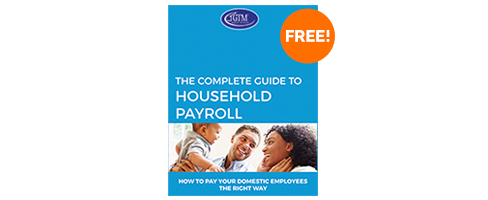
Another advantage of paying your nanny legally? You can use a Dependent Care FSA – offered through your employer – to get tax-free reimbursements on a portion of your nanny’s wages. Here’s how they work when you’re paying a nanny.
There are many reasons to pay your nanny legally. While you can avoid hefty fines and penalties for non-compliance by paying “on the books” and attract high-quality candidates to your job, you can also take advantage of tax savings through a Dependent Care Flexible Spending Account (FSA).
What is a Dependent Care FSA?
A Dependent Care FSA sometimes called a Dependent Care Assistance Plan or DCAP, is a pre-tax benefit account offered by your employer and used to pay for qualified, out-of-pocket dependent care expenses like your nanny’s wages.
It’s an easy way to save money while enjoying the benefits of having an in-home childcare professional looking after your children.
Your child must be under the age of 13 for you to use a Dependent Care FSA for their care expenses. These expenses must be work-related meaning you and your spouse must be working, looking for work, or attending school full-time.
You’ll pay your dependent care costs directly and then apply for reimbursement.
How a Dependent Care FSA saves you money
By putting money into a Dependent Care FSA, you’ll reduce your overall tax obligation as funds are withdrawn from your pay and placed into your account before taxes are deducted. It lowers your taxable income (both for income and FICA taxes) so you end up paying less in taxes.
How much you can save in taxes depends on your tax bracket and your state and/or local income tax rates.
Getting started with a Dependent Care FSA
First, your employer must offer a Dependent Care FSA. Check with your benefits administrator or human resources department to see if this type of FSA is available to you.
You must enroll in the Dependent Care FSA prior to the start of the plan year during your employer’s open enrollment period. Certain life events like marriage, divorce, legal separation, birth of a child, adoption of a child, and change in tax dependents, may allow a special mid-year enrollment.
You’ll then authorize your employer to withhold a set amount of money from your paycheck each pay period. These funds are deposited into your Dependent Care FSA. Again, the money taken out of your pay is pre-tax dollars.
You can contribute a maximum of $5,000 to a Dependent Care FSA as an individual or as a married couple filing a joint tax return. The limit is $2,500 for a married person filing separately. Even if you and your spouse have access to separate Dependent Care FSAs through your employers, your combined contribution limit is $5,000.
The contribution limit is set by statute and is not subject to inflation-related adjustments.
Dependent Care FSA reimbursements
Now that you have your Dependent Care FSA up and running and enjoying the tax-free benefits, it’s time to get reimbursed for your dependent care expenses.
You’ll likely need to complete a claim form provided by your employer and provide receipts or proof of payments. You may need to include:
- date of the expense (or service start and end dates)
- description of the service
- expense amount for reimbursement
- name, address, and social security number (or individual tax identification number) of your nanny
- dependent’s name and relationship to you
Clients of GTM Payroll Services will find a letter on their online dashboard that can be used for Dependent Care FSA reimbursements. GTM clients also have access to their payroll register as proof of payments. If you are a GTM client and need help, call or text us at (800) 929-9213 or email [email protected].
Unlike a Health Care FSA, your Dependent Care FSA funds are only available as they accrue with each payroll deduction. Funds do not roll over from year to year so any unclaimed money remaining at the end of the benefit plan year will be forfeited.
Using the Child and Dependent Care Tax Credit
You may also use the Child and Dependent Care Tax Credit when you file your personal income tax return. You can claim the credit if you paid someone to care for your child under the age of 13 so you could go to work.
The total expenses you can claim with the Child and Dependent Care Tax Credit is $3,000 for one child and $6,000 for two or more children. The credit is 20 percent for anyone earning $43,000 or more. That means the potential maximum credit is $600 (20 percent of $3,000) for the care of one person and $1,200 for two or more children.
You can’t use the Child and Dependent Care Tax Credit for the same expenses reimbursed through a Dependent Care FSA. It will only be applicable to the expenses that exceed your Dependent Care FSA contributions. For example, if you have two children and contribute $5,000 to a Dependent Care FSA, you could apply $1,000 to the Child and Dependent Care Tax Credit before you hit the $6,000 maximum for the tax credit.
It could be very easy for a family with a full-time nanny to use both the Dependent Care FSA and the Child and Dependent Care Tax Credit.
Using a Dependent Care FSA for a senior caregiver
You may be able to use a Dependent Care FSA for a caregiver providing custodial care in your home for an elderly relative. The senior must be physically or mentally incapable of self-care, live with you for more than half the year, and be claimed as a dependent on your tax return.
GTM can help
Looking to take advantage of a Dependent Care FSA and/or the Child and Dependent Care Tax Credit? But paying your nanny “off the books?” GTM can help. We can do back tax work to get you caught up on your nanny tax obligations. Then we can set you up to pay your nanny the right way so you’re compliant with tax, wage, and labor laws and can take advantage of tax-saving programs. Call us at (800) 929-9213 for a complimentary, no-obligation consultation with a household employment expert. Or schedule time with us at your convenience.
Download The Complete Guide to Household Payroll
Get our complimentary guide and learn everything you need to know about paying your employees legally and filing your taxes.





